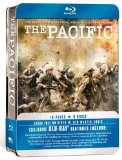| Reviews & Columns |
|
Reviews DVD TV on DVD Blu-ray 4K UHD International DVDs In Theaters Reviews by Studio Video Games Features Collector Series DVDs Easter Egg Database Interviews DVD Talk Radio Feature Articles Columns Anime Talk DVD Savant Horror DVDs The M.O.D. Squad Art House HD Talk Silent DVD
|
DVD Talk Forum |
|
|
| Resources |
|
DVD Price Search Customer Service #'s RCE Info Links |
|
Columns
|
|
|
Pacific, The
THE SHOW:
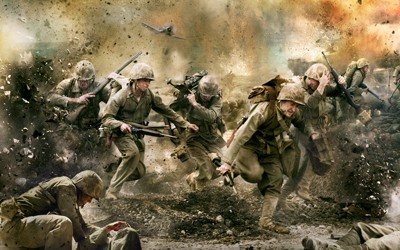
There's a scene at the end of the second episode of The Pacific where four Marines who have spent the previous months stuck in a hole in Guadalcanal have gone onto a relief ship for the first time since they'd been dropped on the island. They are dirty and weak from hunger and basically feeling the toll of combat and having seen too much death. They head down to the mess area because they heard there was coffee, and when the guy running the kitchen asks them if the fighting was as bad as he heard, they scoff. How has this kid even heard of Guadalcanal? He responds that everyone has heard of Guadalcanal, and that the 1st Marine Division are considered heroes back home in the States.
The hardened soldiers pause. They had no idea they weren't forgotten, that anyone had been talking about what to them seemed like a hollow, minor victory. The look in their eyes is somewhere between shock and heartbreak, like they don't know what to do with the fact that what they have done has actually mattered. It's hard not to get a little choked up seeing it.
Because, of course, what the veterans of World War II did mattered, and it continues to matter. In 2001, HBO aired the miniseries Band of Brothers, a ten-part, monumental undertaking showing the 101st Airborne Division of the U.S. Army in the theatre of war in Europe. It stands as one of the hallmarks of modern television, and a considerable achievement for a network that has been redefining the term "quality" on the boob tube for a while now. Nine years later, The Pacific is their follow-up, and as the title would suggest, focuses on the other side of the war: the campaign against the Japanese in Southeast Asia. The Pacific has big boots to fill, and it does a damn good job of filling them. This series is different, it's not necessarily going to inspire the same patriotic fervor as Band of Brothers, but that's because the field of operations was different, and so was the fighting.
Jungle warfare is less personal, more anonymous. The Marines usually couldn't see their enemy, they just fired into the trees. The conditions were brutal. Rain, mud, humidity--hot or cold, the men were constantly drenched. For the men on the ground, the goals seemed less tangible. Why fight for a strip of land with nothing on it out in the middle of the ocean? What was the point? The maneuvers were over dots on a map in places most of the guys couldn't even pronounce. In episode five, the men rush onto a beach while under heavy Japanese fire; the ones who survive are then forced to run across a bombed-out airfield, seemingly toward nothing. They must forge ahead.
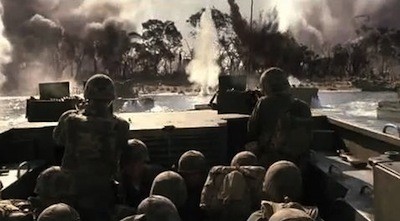
The Pacific begins in the months after Pear Harbor and follows the Marines throughout the war, working their way up through the South Pacific toward Japan. There are recurring characters, naturally, though unlike Band of Brothers, we don't follow the same soldiers as consistently. Many of the characters cycle out through the show, giving the producers opportunities to check in on the homefront. Some men die, of course, and others are sent home for wounds. Sgt. John Basilone (Jon Seda) is rewarded for his valor and sent back to America to sell war bonds (similar territory to Clint Eastwood's Flags of Our Fathers, actually; Basilone ends up being the focus of Episode Eight), while PFC Sidney Phillips (Ashton Holmes) serves his time and is relieved of duty. His discharge makes for an interesting trade-off. We meet Phillips in the first episode, back in his hometown of Mobile, Alabama, and we also meet his friend, Eugene Sledge (Joseph Mazzello), whose own enlistment is delayed by a heart murmur. In episode five, Sledge finally makes his way out to the battlefield only to see his best pal leave. Yet, the new character brings a new vigor and provides contrast, showing just how quickly the other men have grown up.
Sledge wrote two books about his time in the war, and his writing is one of the major source materials for The Pacific. The other is the book Helmet for My Pillow, written by Robert Leckie (played in the series by James Badge Dale, now on AMC's Rubicon). If you had to nail down who the main characters in the show are, those would be the two, and as a writer and a cynic, I naturally gravitate to Leckie. He serves as the voice of disillusionment, and there is a thought-provoking crossover scene when he meets Sledge and they discuss the role of God in a war. Two of my favorite episodes in the series actually have less to do with fighting and more with the experiences Leckie has away from the bombing. Episode Three shows the men in Australia and Leckie's romance with the daughter of Greek immigrants. (She is played by Australian actress Claire van der Boom, who was so good in The Square, I was pleased to see her again.) The other is Episode Four, where a nervous condition gets Leckie sent to a hospital on another island, and his recuperation gives us a glimpse into the mental toll the fighting is taking on the men.
The staging of the show is, of course, important, and the simulation of war here is comparable with any of the top movies in the genre. The fighting is fierce and brutal, with an emphasis on portraying how chaotic and relentless the clashes were. The Pacific does not glamorize the death and violence, it is as gross and awful as the real thing; that said, it also doesn't fall into any trap of letting the "war is hell" message lessen the nobility of the participants. On the contrary, the men appear all the more heroic for sticking it out. The casting is excellent down to each and every man. The actors all deliver complex performances, avoiding the stock WWII movie clichés. Mazzello, Badge Dale, and Seda all three concoct thoughtful portrayals that grapple with the humanity of the men they are honoring. Another notable stand-out is Rami Malek as Merriell "Snafu" Shelton, a soldier from New Orleans that definitely follows his own drummer. Malek's snaky take on the man begins as almost caricature, but gradually grows more real without losing any of the odd rhythm.
The final episodes of the show take us to Iwo Jima and Okinawa, and then for the last, post-VJ Day as the men return Stateside. There is happiness and sadness alike to be found after the war. Post-Traumatic Stress Disorder is covered a lot in regards to Vietnam and the conflicts that have happened since, but it's never been a large component of stories about the Greatest Generation. Again, Leckie and Sledge provide our counterpoints. The cynic finds renewed vim in returning to his old life, while the one-time optimist finds reconstructing his soul a little harder to come by. Joseph Mazzello's best work actually comes at the end of Episode Nine, when he realizes that he has turned into a killing machine. It's then we grasp how deeply we've seen this man dismantled, and what it might take to put him back together.
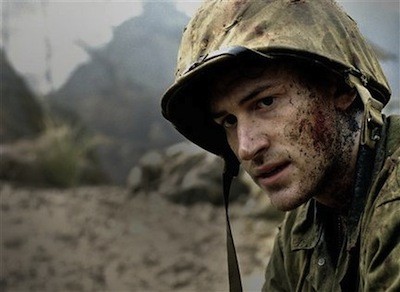
THE DVD
Video:
All ten episodes of The Pacific are on five discs, with a sixth disc devoted to supplemental features. The 1080p high-def transfers are presented here at a 1.78:1 aspect ratio, and they look absolutely stunning. The image is clear, but gritty. Every speck of dirt is visible, whether it's smeared on a soldier's face or shooting into the air due to an explosion. The war scenes move fast, and the digital clarity means we can be right there in the action, with no blurring or macroblocking or any other problems. Colors are finely tuned, blacks are pitchy and deep. In other scenes, vast horizons are gorgeous. This is as good as it gets in terms of image quality.
Sound:
Try not to annoy your neighbors with the booming DTS 5.1 soundtrack. The gunfire and bombs will rock your speakers, and overall, there is a fantastic use of forward and back, left and right, to give an immersive audio experience to the viewer.
Alternative language mixes include 5.1 dubs in French and Castilian Spanish, and 2.0 mixes for a Latin American Spanish version and a Polish overdub. All of these languages are represented in subtitle tracks, as well as ten other languages. This includes an English subtitle option geared toward the deaf and hearing impaired.
Extras:
The Blu-Ray of The Pacific mimics the design of the Band of Brothers collection--though it is the smaller size of the new format. The discs are held in a decorated foldable book, with a plastic tray for each one, and the whole thing closes up to fit in an embossed tin. Inside the tin's lid is a printed episode guide. There are a couple of paper inserts, as well, advertising related products.
Each episode of the show has different extras specific to the segment. There are two shows on each disc (each ranging 50 minutes to an hour), and you can hit play for both, or you can choose one show at a time. Going with the latter is optimal on first viewing, as it's the only way to choose the historical introductions that ran before each broadcast. Narrated by Tom Hanks, and featuring historical footage alongside interviews with veterans, these short intros give much needed background and bridge the gaps between shows. (Hanks was one of the executive producers of The Pacific, as was Steven Spielberg. Both appear on the extras as commentators.)
For each show, BD users also have two different choices for how to go deeper into the history. Judging from the packaging, these features are not on the standard DVD, so buyer beware when making your choice. Option 1 is "Enhanced Viewing," and this is, for all intents and purposes, a multimedia commentary track. As you are watching, there will be pop-ups: text-based facts, maps, or picture-in-picture interviews with historians and veterans and vintage documentary footage. The second option is a "Field Guide," and this allows you to move along timelines for each episode and choose more illuminating features in four categories: Maps (spotlighting battlefields and troop movement), Marines' Experiences (personal stories from the field), Historical Overview (more about specific events), and Facts & Bios (looks at individual soldiers and other background-type stuff).
Disc 6 closes out the package with three supplemental sections:
* "Profiles of The Pacific": biography segments on six of the Marines portrayed in the series. It's interesting to see the real guys and match them up to their movie counterparts, and in some cases, we get to see what they look like in old age. Not all of the soldiers were still alive when the interviews were recorded in 2004, but there is archival footage and photos, including a 1995 interview with Robert Leckie and one with Eugene Sledge from 1991. Friends and family fill in the rest. These all run 10 minutes or less.
* "Making The Pacific": A half-hour behind-the-scenes documentary.
* "Anatomy of the Pacific War": A 10-minute documentary about this particular theater of combat with a focus on our enemy. The Japanese military culture is discussed, as well as our reaction to it, including the role of wartime propaganda.
[The above are all also available on the regular DVD edition.]
Altogether, these extras create an illuminating tutorial on the real-life that went into this amazing dramatization. It's educational, but never boring.
FINAL THOUGHTS:
DVD Talk Collector Series, without a doubt. The Pacific is a crowning achievement in television, proving once again that many current television series are rivaling big-screen cinema in terms of scope and depth of story. This follow-up to Band of Brothers takes viewers on a 10-part journey through the campaign against Japan in World War II. The harsh conditions of combat are re-created in startling detail, illustrating the sacrifice of the men who fought on the beaches and in the jungles through a selection of intriguing, complex characters. This is as good as it gets, and whether you are a fan of war movies or just good drama, The Pacific offers many rewards for the time investment. As per usual, the HBO home video presentation is top notch, with the Blu-Ray release in particular having in-depth historical supplements to broaden the consumer's knowledge of what really went on out there. This is a must-buy if ever there was one.
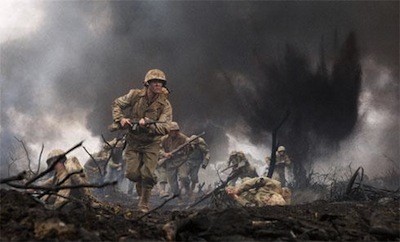
Jamie S. Rich is a novelist and comic book writer. He is best known for his collaborations with Joelle Jones, including the hardboiled crime comic book You Have Killed Me, the challenging romance 12 Reasons Why I Love Her, and the 2007 prose novel Have You Seen the Horizon Lately?, for which Jones did the cover. All three were published by Oni Press. His most recent projects include the futuristic romance A Boy and a Girl with Natalie Nourigat; Archer Coe and the Thousand Natural Shocks, a loopy crime tale drawn by Dan Christensen; and the horror miniseries Madame Frankenstein, a collaboration with Megan Levens. Follow Rich's blog at Confessions123.com.
|
| Popular Reviews |
| Sponsored Links |
|
|
| Sponsored Links |
|
|
| Release List | Reviews | Shop | Newsletter | Forum | DVD Giveaways | Blu-Ray | Advertise |
|
Copyright 2024 DVDTalk.com All Rights Reserved. Legal Info, Privacy Policy, Terms of Use,
Manage Preferences,
Your Privacy Choices | |||||||









